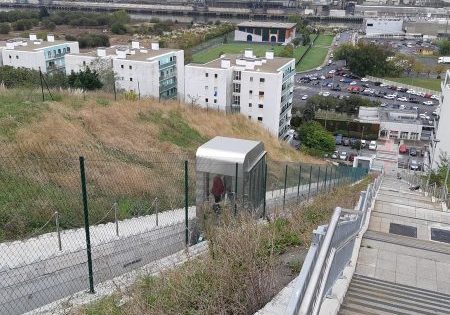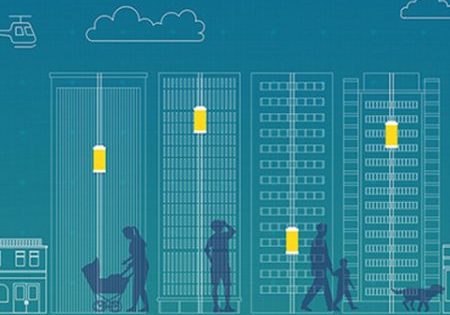Challenging Our Thinking Regarding Lift Incidents
Feb 28, 2022
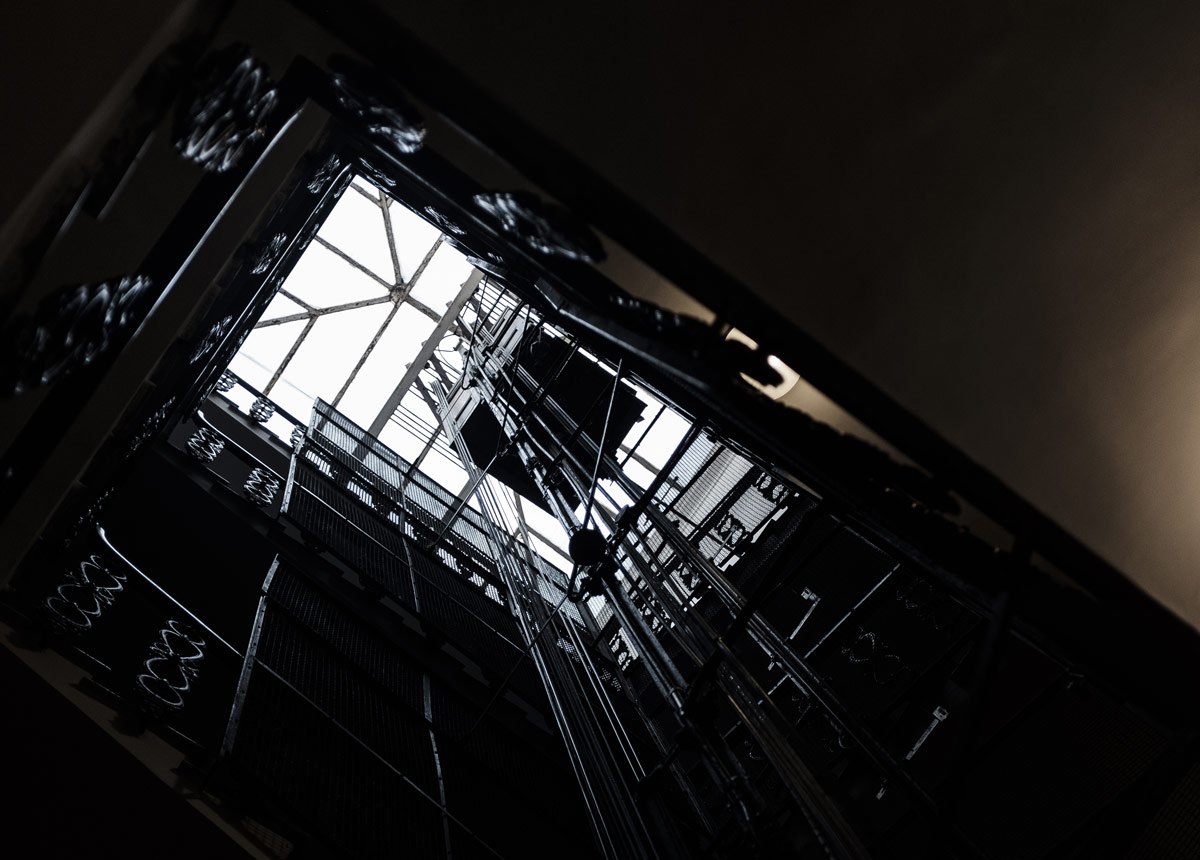
by Roger Kahler and Nicholas Pierce

This paper was first presented virtually at the 12th Lift & Escalator Technologies Symposium in September 2021 and printed at the symposium website at liftsymposium.org.
Keywords: Class I, Class II, Class III, taxonomy, energy
Abstract
The purpose of this paper is firstly to present an understanding of the elevator fatality problem. Fatalities will then be presented in the context of the overall burden of personal damage. Damage to people can be classified as multiple fatality, single fatality, non-fatal permanent damage, temporary and minor damage. The patterns or taxonomies associated with each class of damage are generally quite different from one another. The paper will suggest that the damage class of non-fatal permanent damage represents 80% of the cost of all damage (by any measure) and yet data with respect to elevators is seriously lacking on this class of damage. If we cannot describe the non-fatal permanent damage problem, we form hypotheses as to whether or not it is simply a subset of another level of damage. For example, a hypothesis could be “non-fatal permanent damage is a subset of fatalities. Therefore, manage fatalities and you will manage non-fatal permanent damage.”
If the hypothesis is true, the overall size of the problem will alter. If the hypothesis is not true, we do not impact a critical class of damage. The proposition that was put before the conference is that we cannot describe the size and nature of the problem associated with non-fatal permanent damage associated with elevators. Herein lies an opportunity, but the beginning point is the recognition of the gap.
Additionally, the paper will present a model for thinking about the timeline of an elevator fatality event, suggesting there is still much more to do in the engineering space versus the procedural/training space. For example, engineers need to be challenged to think about elevator equipment and the elevator shaft more strongly as an information detector, information processor and decision maker. This will allow for controls to be found in the metastable and unstable time zones of an incident. Several elevator fatalities will be presented to illustrate.
1. Introduction
The objective of health and safety activity should be the elimination of permanent damage to people. This objective when applied to the lift industry has application to the manufacture, installation, operation, maintenance and eventual decommissioning. If we are to manage future potential damage to people, we must first be able to describe which classes of damage we are wanting to eliminate or minimize. We must then be able to describe the patterns of damage (the taxonomies) associated with that class of damage. Then, we can use appropriate models to challenge how we understand the damage that occurs and devise effective controls. This paper suggests that there is still much to do with respect to lifts and escalators.
2. Damage to People
In engineering terms, damage to people, equipment or the environment can be considered a consequence of an energy exchange wherein that energy exchange exceeds the tolerable limits of the structure. In this paper, we are interested in the human structure. The energy exchange can occur in milliseconds (such as a fall where the head strikes a hard surface) or it can be a series of moderate energy exchanges that occur over a timeframe of seconds or minutes and are separated in time (such as heavy lifting tasks). Additionally, it can be a very low-level energy exchange that requires months and years of exposure time (such as chemical absorption through the skin, or respiratory inhalation of particulates/mists/fumes). The reality is that to confine our discussion of damage such that we only classify it as an injury has the lift industry potentially missing two of the three types of energy/time relationships described above. If one does not embrace the above time dependency notion of an energy exchange, it becomes more difficult to move closer to the overall objective that safety and health activity should be the elimination of permanent damage. So often, safety activity has focused on those energy exchanges measured in milliseconds and health activity has focused on those energy exchanges measured in months and years, which has left those series of moderate energy exchanges in no man’s land. That observation, combined with the mythologies such as “lift correctly, use the knees and not the back,” has partly contributed to the epidemic of musculoskeletal damage.
3. Classes of Damage
To achieve the objective of the elimination of permanent damage to people in the lift industry, it is necessary to couple the notion that damage is a consequence of an energy exchange (with a time dependency relationship for the various types of damage) with the idea that there are different classes of damage.
Damage to people can be usefully classified as Class I (permanent), Class II (temporary damage/full recovery) or Class III (minor irritation).
Class I damage involves permanent alteration of life and includes three sub-categories of:
- multiple fatalities
- single fatalities
- non-fatal permanent damage
Non-fatal permanent damage includes an upper level wherein a person does not return to work, and a lower level wherein the person returns to work but in a limited capacity, time or skill.
It is necessary to understand the relative importance of the cost of Class I, II and III damage. Direct costs and indirect costs are associated with the person’s damage. As one examines Class I damage, it becomes increasingly clear that the majority of the cost is borne by the community, the individual and their family, and not by the employer and the insurer. Australian National Studies[1,2,3,4] clearly demonstrate that the majority of the cost of Class I damage is associated with the non-fatal but permanent damage category of Class I and the cost is borne by the worker, their family and the community. In the main, this is because these people either:
- Do not return to work and are eventually separated from the insurance system. Their income and standard of living decreases, or
- They cannot return to the same work but are engaged in a reduced-income situation, or
- They are supported by a government-funded social security system.
The reader is referred to the source documents for a more detailed explanation.
With respect to Class II damage, it is borne by the insurer and the employer for those countries that have established compensation systems. With respect to Class III damage, the cost is borne by the employer as the damage is managed totally in-house.
Australia is one of the few countries that has attempted to establish the true cost of the different classes of personal damage. The insights gained over some 30 years of study by federal government departments reveal dramatic findings.
The big picture is presented as per the following Table 1[1,2,3,4].
*Without pain, suffering and early death costed

In Australia’s legal system, there is a cost attributed to pain and suffering and early death. The above relative costs do not include those parameters for the Class I non-fatal and fatal damage, and so understate the importance of Class I damage.
The following Table 2[1,2,3,4] gives further insight.

It is recommended that the reader study this table and be staggered by not only the numbers involved but the very high cost associated with Class I non-fatal permanent damage. It is proposed to this audience that Class I non-fatal permanent damage often slips under the radar and that the Class I non- fatal permanent damage that is of current interest to employers is the one involving a hard, sharp energy exchange producing traumatic damage, e.g., amputation/crushing.
The data in the tables above is supported by individual studies by workers compensation authorities of the various states of Australia.
The following Figure 1 and Figure 2[5] show that it is the 10% of Class I non-fatal permanent damage cases that represent the majority of the cost. These people are not malingerers but have suffered permanent impairment to the musculoskeletal system as measured by such objective measures as the American Medical Association Degrees of Impairment Tables.
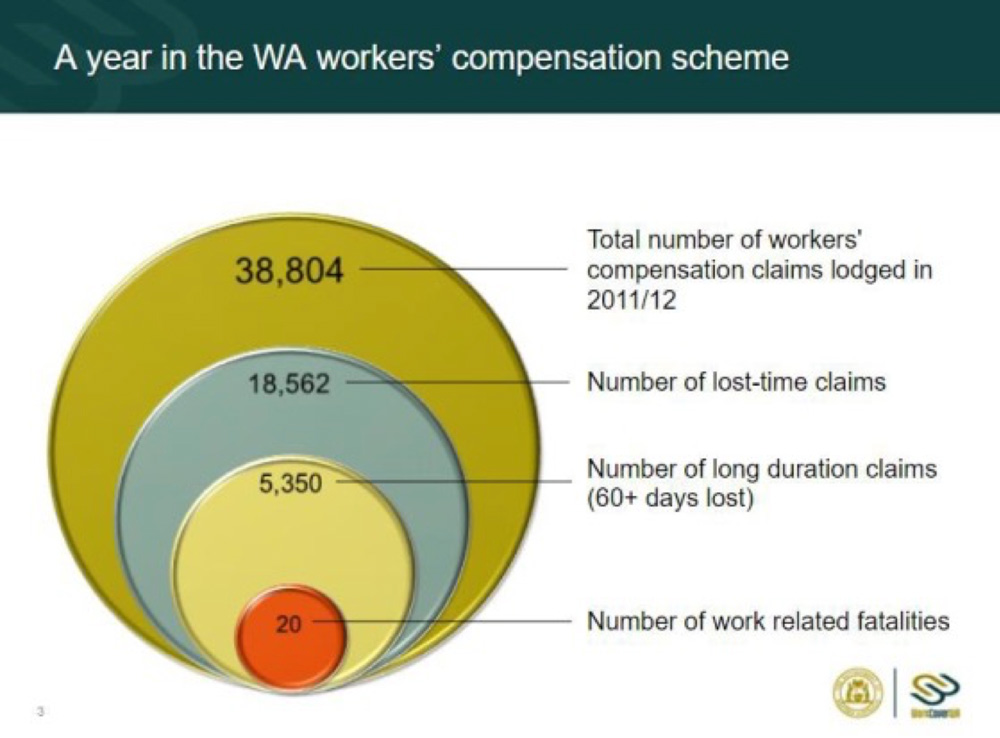

The 80/20 rule will be known to the audience. It has its origins in Europe from famous Italian Alfredo Pareto. The application of the 80/20 rule to the various classes of damage reveals — without a shadow of doubt — that Class I non-fatal permanent damage is the class of damage that costs the most by any measure. However, for ethical, moral and legal reasons — and a genuine love for people — fatalities must be avoided. This is the other category of Class I damage.
With this preamble, the health and safety objective is restated as the “Elimination of Class I Damage.. It is then absolutely beholden upon the lift and escalator industry to be able to describe the pattern of Class I damage for the various activities of manufacture, installation, usage, etc., if the objective is to be reached. Being driven by data is essential.
4. What Data Is Required?
The medical profession has made the advances that it has because it has progressively moved away from an egocentric/human error-centered model to recognizing that there is complex interplay among a host, an agent, the environment and a vector. The following Figure 3 illustrates the model.
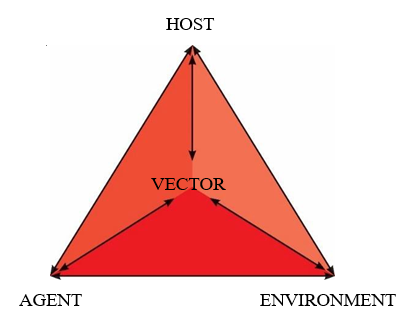
The model is supported by epidemiological work so that the patterns and the incident rates can be clearly described, and research effort strongly directed. We suggest that the lift industry cannot strongly and succinctly communicate the pattern of Class I fatal and Class I non-fatal permanent damage, remembering that Class I damage is the Pareto Class of Damage by any measure. The oldest of the scientific tools is taxonomy or pattern analysis, which, when it matures, becomes epidemiology. The lift industry needs to “start the walk” of developing taxonomies for the different sub-classes of Class I damage and then watching for the effect of change over time upon that pattern — be it positive or negative.
In Australia, patterns or taxonomies do exist for many industries, e.g., mining and construction. The taxonomies that give significant insight are those that are completed by the energy involved in the damage and taxonomies that go into sufficient detail to observe the relative importance of taxons (sub-groups) within the taxonomy. The critical learning from previous taxonomic work is that the pattern or taxonomy of Class I multiple fatalities is similar to — but essentially different from — the pattern of Class I single fatalities. The pattern of Class I non-fatal permanent damage is similar to — but essentially different from — the pattern of Class I single fatalities. Your authors suggest that, in the absence of information for the lift industry, the above hypothesis holds true.
This is not to say that there have not been studies completed for the lift industry or a desire by the industry to eliminate Class I damage at any level. Good work has been done. Standards continue to evolve.
Just a few of the many injury data documents include Deaths and Injuries Involving Elevators and Escalators[6], Journal of Forensic Sciences[7], and ThyssenKrupp Newsletter[8]. There are studies completed that give some useful insights, but the data analysis needs to be elevated to the next level. The current information surrounding lift and escalator fatalities generally appears to be more insightful than the information surrounding Class I non-fatal permanent damage. When one examines the data of non-fatal damage (classified as injuries), it does not focus on the Class I non-fatal permanent damage but instead on serious injury. The definition of serious in-studies involving compensation data typically include claims involving greater than five days’ work. This level of damage (>5-10 days lost) is not necessarily the predictor of the Class I non-fatal permanent damage. This >5 days lost data will include a significant amount of Class III (temporary) damage. It is only when one studies data sets >60 days lost that the pattern matches the Class I non-fatal permanent damage problem. It is being suggested that the current studies of injury are useful and helpful but not sufficiently focused, and that the Class I non-fatal permanent damage is camouflaged in the injury datasets.
The following tables and figures[9] are useful with respect to the fatality story:
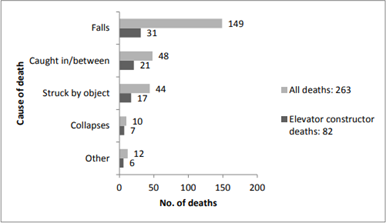
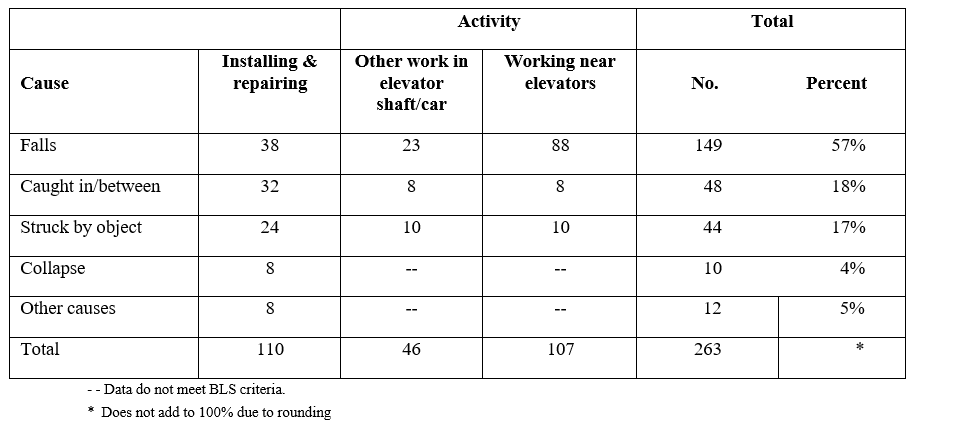
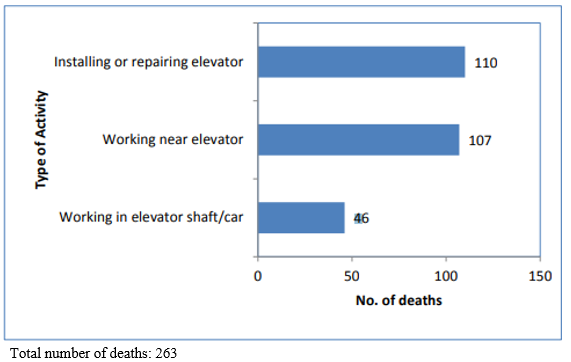
The following Figure 4 is the authors’ attempt to develop the taxonomy from the 110 people described in Tables 3 and 4 who died installing and repairing elevators between 1992 and 2009.
It is necessary to show meaningful patterns with associated describers. This type of analysis is the starting point. The industry must be able to accurately describe the Class I problem and then come to understand the phenomena involved in the various taxons so that health and safety resources are appropriately directed.
Quality descriptive data (supported by codified data, e.g., occupation) of individual events is critical to building a meaningful taxonomy to show that there is a desperate need for quality taxonomic information in the first instance to be able to understand the patterns and the relative importance of the mechanisms by which various energies are damaging people.
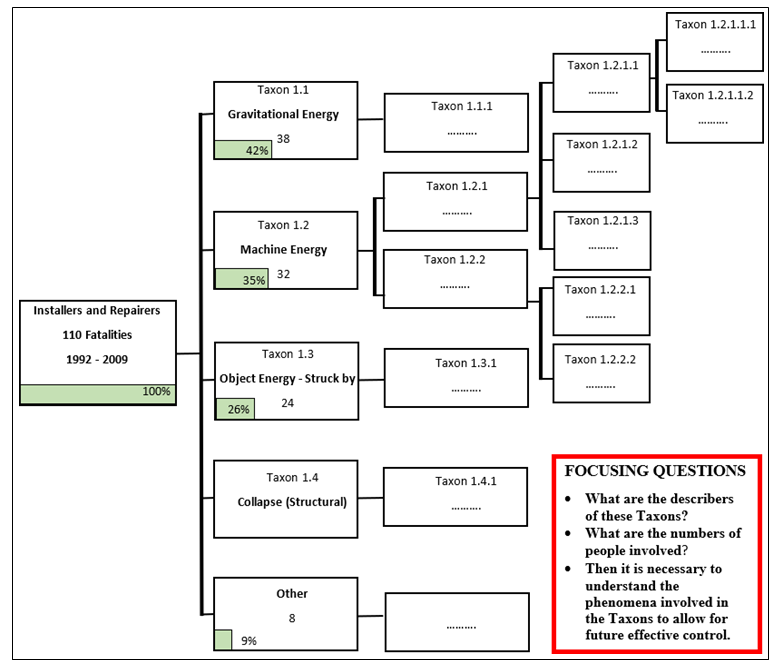
Similar comments can be made when one looks at publications with respect to injury because they do not filter out the Class I non-fatal permanent damage. Current injury studies are useful in that they show the involvement of falls of people, musculoskeletal damage from manual tasks, etc. However, there is not sufficient insight in the data analysis to strongly direct health and safety activity.
4.1 Two Deaths
Our own experience with two escalator fatalities is useful in that it gives the authors’ insights into one aspect of the mechanism of death and the associated controls, but those deaths do not get captured in a dataset that assists the industry in understanding the relative importance of the energies and mechanisms involved in fatal incidents.
The following Figure 5[8] illustrates where the pathway of movement beyond the edge commenced.
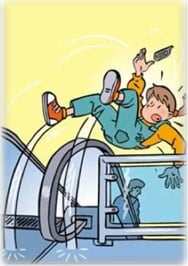

There is a common notion that such fatalities are due to bad behavior, lack of attention and carelessness. Figure 6[8] reinforces that mythology. Figure 5 shows the movement pathway of two deaths that the authors’ investigated. In one case, a child grabbed the rising part of the handrail and was lifted up and carried over and fell to their death. The second involved a young lady being embarrassed as her boyfriend went to give her a kiss in a public environment and she stepped back, and her clothing interacted with the rising part of the escalator handrail to lift her up and carry her beyond the handrail, causing her to fall to her death. In both incidents, a common feature was the exposed and rising part of the handrail. This becomes the first point of challenge: Both people were behaving reasonably. The exposed section of the rising handrail was essential to the incident, and the absence of a barrier to prevent them moving beyond the edge was also essential. Probably some 15 years after investigating those two deaths, the industry in Australia commenced to use safety barriers, but we still fail to address the rising part of the handrail. The authors are sure the two stories will create some disagreement, but the point being made is that, as an industry, we are not building useful datasets that aid in understanding and give insight into the relative importance of the different mechanisms by which people lose their lives or are permanently damaged as a result of using lifts and escalators.
The view is supported by Ruibal, et al.[10]:
“There is a real need to collect reliable escalator accident data which could help identify potentially dangerous situations that can be sources of risk for users or technicians on escalators.”
5. Challenge Our Way of Thinking
As we think about Class I damage and come to better understand the pattern and relative importance of the different mechanisms of energy transfer, we will then need to challenge our thinking about individual damaging occurrences. It is not to say that some very significant thought and analysis of Class I damaging occurrences is not happening, but we do not think it is sufficiently widespread. There is a strong belief in accident prevention and the desire to stop situations moving out of control. Many of the outcomes of investigations are administrative in nature, and yet in the lift industry, we seek out controls that are operating as a situation commences to move out of control, is out of control and damage is occurring.
The following Figure 7 illustrates the timeframes through which situations pass with the length of those time zones dependent upon the timeframe of the event under consideration. The timeline forms part of the InterSafe Essential FactorsTM model.

The lift industry has many controls that operate in the metastable, unstable and damage time zones of Figure 7. Examples involve detecting the presence of the person in the pathway of closing lift doors. This is a control that operates in the metastable time zone.
When a lift is in freefall and the safety brakes apply, the rate of application of the safety brake can result in very significant jerk (rate of change of acceleration), which results in permanent damage to people but prevents fatalities. The safety brake is a damage-reduction device. It is not an accident-prevention device.
For the industry to make further progress, we must force our thinking into the fast timeframes of instability and damage and learn to think in terms of the concept of meta-stability. This is the timeframe in which the participants in the incident often consider the situation to be stable when, in fact, it is moving out of control but recoverable. Perhaps the concept is best demonstrated by example: The following case study (Figure 8) is in the public arena[12]:
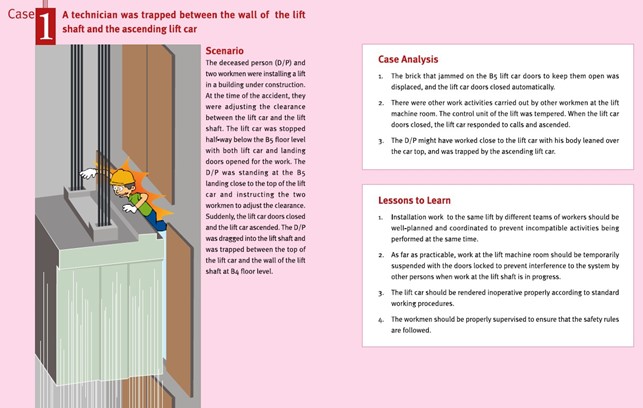
If one were to read the Lessons to Learn (above), they are totally focused on keeping the situation under control and in the stable time zone of Figure 7. As the situation progresses beyond stability, it is often necessary to have a very strong focus on the machine and the work environment of the lift shaft. These components can be considered as information detectors, information processors and decision-makers, as the reaction times of people are often far too slow in the fast-time frames of unstable and damage. Technology has made rapid advances in the last 15-20 years in which equipment and the work environment can be considered as an information detector, processor and/or decision-maker. The lift shaft environment is very unforgiving when a person is in the travel path of either the lift or the counterweight. Perhaps there is real opportunity going forward that either the lift, the counterweight or the lift shaft itself can act as an information detector, processor and decision- maker, in that it recognizes that an object is moving toward a susceptible structure, e.g., a maintenance person, and that there is a need to intervene. The concept may sound abstract, but unless we are to apply increasing rigor with respect to personal damage, the stories depicted in the case study will continue with similar lessons learned and the taxonomy of fatalities will not alter.
Another example is provided to challenge our thinking: The Hierarchy of Controls could be rebranded Control Options and placed on the event timeline as follows:
- Elimination: operates in the Predisposing time zone of Figure 7.
- Administrative: operates in the Stable time zone of Figure 7.
- PPE: operates in the Unstable/Damage time zone of Figure 7.
- Engineering: can operate in any of the time zones of Figure 7.
A scientist’s models and language must be more neutral and objective. Control Options is neutral and objective. Hierarchy of Controls implies good and bad, best and least, and invokes value judgments.
For the person who reads this paper and is interested in a more comprehensive range of control options, they are referred to the paper by William Haddon, “On the Escape of Tigers,”[13] which lists 10 strategies for managing an energy exchange. What is fascinating is that the paper was written by a medical practitioner venturing into the province of energy and engineers. Haddon’s 10 strategies for managing an energy exchange effectively derive from the medical profession’s desire to intervene in the prevent phase of the disease, at multiple points of time in the event phase of the disease and then in the post-event phase. We have much to learn from the medical profession.
Figure 9 illustrates Haddon’s 10 Energy Management Strategies overlaying the event timeline:
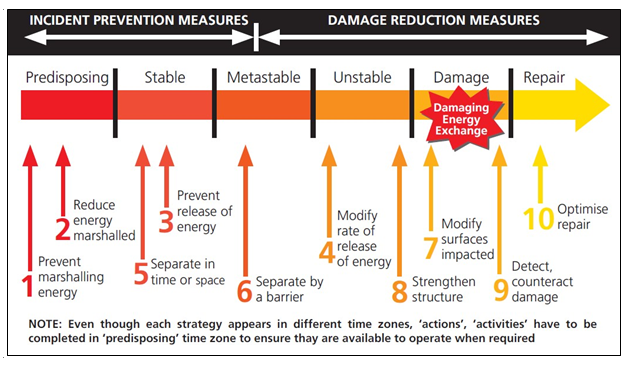
6. Summary
This paper is not intended to denigrate or detract from the significant work and gains that are being made in the lift industry, but to challenge some of the baseline thinking that allows opportunities to go unnoted as we study individual cases of personal damage.
The paper joins others on the same subject that contend we are in desperate need of quality taxonomies of Class I damage associated with multiple fatality, single fatality and non-fatal permanent damage.
The following recommendations are made for the industry with respect to a study of Class I damage:
Firstly, the industry association to collect descriptive and codified data of fatalities and non-fatal but permanent damage (traumatic and over-time damage) and >60-days-lost cases* from:
- Insurers
- Large and medium-sized lift manufacturers and installers
- Government agencies
*The taxonomies of non-fatal but permanent damage cases for other industries reflects ≥60 days lost taxonomies. Setting a threshold of ≥60 days lost will increase the data set.
This data to be collected for the various groups of:
- Manufacturing
- Installation and commissioning
- Repair
- Users (general population)
Aim for several thousand records over a 10–20-year period. This will be the most time-consuming aspect of this study.
Secondly, complete eight taxonomies using an agreed-upon set of describers, e.g., energy that damaged for each of the four groups (a fatal taxonomy and a non-fatal but permanent damage taxonomy for each group).
Thirdly, to share the learnings and each recipient of the taxonomies to implement change within their sphere of influence.
References
[1] Industry Commission, Work Health & Safety, An Inquiry into Occupational Health & Safety, Vol 1: Report, Report No. 47. Industry Commission, Australia, September 1995
[2] National Occupational Health & Safety Commission, The Cost of Work-Related Injury and Illness for Australian Employers, Workers and the Community, August 2004, Canberra
[3] Australian Safety and Compensation Council, The Cost of Work-Related Injury and Illness for Australian Employers, Workers and the Community: 2005-2006, 2009.
[4] Safe Work Australia , The Cost of Work-Related Injury and Illness for Australian Employers, Workers and the Community: 2008-09, March 2012, Canberra
[5] Glasby, L, Long duration claims Statistics, Workcover WA, 2013. https://slideplayer.com/slide/7760131/
[6] McCann, M, Zaleski, N, Deaths and Injuries Involving Elevators and Escalators, CWPR, July 2006
[7] Forensic Sciences, May 2020, Vol.65, No.3
[8] ThyssenKrupp, Newsletter – Safety Curtains 001 – Ph Engel. August 2011
[9] McCann, M. Deaths and Injuries Involving Elevators and Escalators, CWPR, September 2013 https://www.cpwr.com/wp-content/uploads/publications/elevator_escalator_BLSapproved_1.pdf
[10] Elena González Ruibal, Isabel Gonzáles Mieres, Ignasi Oliver González, David Cooper, José Durán Batalla, Escalator Accidents Analysis, 5th Symposium on Lift & Escalator Technologies
[11] Intellectual Property of InterSafe
[12] Occupational Safety & Health Council Hong Kong, A Casebook of Fatal Accidents in Lift Installation, Maintenance and Repairing Work, 2004
[13] Haddon, W., On the Escape of Tigers: An Ecologic Note, Technology Review, Vol 72, No. 7, May 1970 InterSafe, Unit 1, 5 Henry Street, Loganholme, Queensland 4129, Australia
Nicholas Pierce is a mechanical engineer with 20 years industrial experience. His background is primarily in the field of design, construction and maintenance of fixed plants and equipment. As a specialist investigator, Pierce has investigated more than 100 incidents involving fatalities, permanent damage to people and extensive damage to equipment. These include investigations in the mining, construction, manufacturing, transport and energy industries using InterSafe’s Essential FactorsTM models. This has included elevator incidents involving workers in elevator shafts, passengers using elevators and people being rescued from elevators. Pierce has also undertaken studies of the patterns of fatal and non-fatal-permanent damage of people in the construction and mining industries to understand the dominant damaging energies and incident types to assist industries in prioritizing their risk management activities.
Also read: The Use of Lifts in Offices in Social-Distancing Environments
Get more of Elevator World. Sign up for our free e-newsletter.





